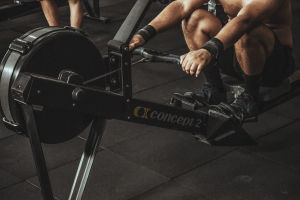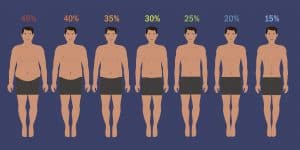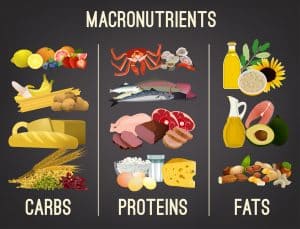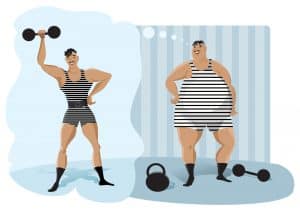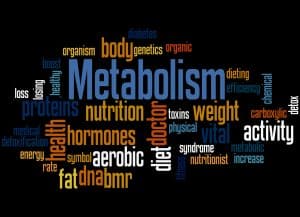Weight loss isn’t as simple as shedding pounds until you look good. To maintain your health after you lose weight, it’s important that you do not force your body out of proportion. A healthy weight can be determined by the amount of fat you have to spare, in relation to the rest of your body.
An understanding of your body composition can help you set realistic (and healthy) weight loss goals. It’s also beneficial to muscle growth, as you’ll be able to determine how much muscle you should have based on your size, weight, and other proportions.
- Table of Contents
What Is Body Composition?
Before I get into how you should be calculating your weight loss, you have to understand what body composition is. There seems to be some confusion when it comes down to it, and it’s often (incorrectly) used interchangeably with body mass index.
There’s a third factor to how your body loses weight, and it’s often overlooked—your basal metabolic rate. Understanding their differences is simple, but could change how you approach fitness. Here’s a look at each of them.
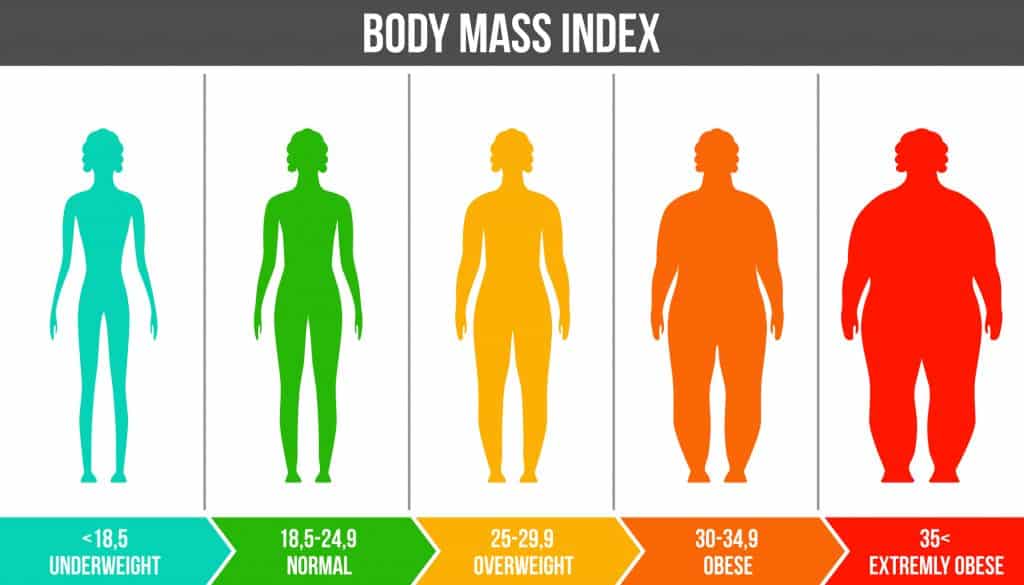
Body Mass Index (BMI)
It’s false that your body mass index is the most important factor in weight loss, but it’s easy to see why it’s such a popular misconception. It’s merely a way to calculate if you are within healthy weight parameters according to your height, age, and gender.
The true purpose of calculating your BMI is to determine if you are underweight, healthy weight, overweight, or obese. While this does help with weight loss because it allows you to gauge how far above or below the standard you are, there is one significant problem.
Body mass index does not determine how much fat you have, or how much you should lose. You will know if you have a weight problem, but it’s not exactly an accurate method of planning weight loss.
This is because your BMI cannot tell you how much of your body is fat. This is also a flaw in using a scale to weigh yourself; you won’t know how much of your total mass is fat. That’s where body composition comes in.
Body Composition
Opposed to BMI, which can tell you how overweight you are, body composition tells you how much fat you’re made of. Even so, it’s not so simple. For body composition to benefit you, you must understand that weight and fat are two separate things.
Think of how some bodybuilders weigh a lot but are not considered obese. This is because in muscle building, your muscles—not fat—account for most of your overall mass.
Another consideration here is that human bodies are built from the same components. Our organs, bones, and tissues also contribute to our weight, but—in conjunction with fat—our mass will still vary.
This could add to the unreliability of using BMI to calculate weight loss. It will give you an average based on others in your demographic, but the formula isn’t tailored to you as an individual.
This is a key factor in the importance of knowing your body composition. You can calculate your percentage of fat compared to your lean mass, according to your exact proportions.
Basal Metabolic Rate (BMR)
Your BMR is, in effect, what those outside the medical field would simply refer to as the metabolism. It’s all too easy to use it as a buzzword, and carelessly describe it as either fast or slow, but this means nothing unless your body composition is accounted for.
Your BMR is how much energy your body requires to function. Body composition matters because no two metabolisms are the same. This is why you may find two people of similar size and age—one of whom can eat a truckload to no ill effect, the other who’ll eat one ice cream and pay for it with their hips.
An interesting thing to note though is that the more lean mass you have, the greater your BMR will be. One way to look at this is that the more muscle you have, the faster you’ll burn fat.
To summarize—your BMI tells you whether or not you’re overweight. Your BMR is the rate at which you burn energy (or fat). Body composition is how much of you is fat, compared to muscle, bone, organs, and other components of your body.
How does this factor into weight loss and muscle growth, though? Is it possible to change your body composition? To answer these, we must delve deeper into body composition, and take a closer look at what we’re made of.
Lean Mass, Fat, and Fat-Free Mass
We have to divide our components into two categories: fat and fat-free mass. Body composition, in layman’s terms, is the proportion of one in relation to the other. Generally speaking, the higher your percentage of fat-free mass is, and the lower your percentage of fat, the healthier you are.
Not all fat is bad, but when your body carries excess non-essential fat, it becomes problematic. Fat is found all over your body, most prominently in your tissues, around your organs, and under your skin.
Lean body mass and fat-free mass seem similar at first glance, but they are not the same thing. Lean body mass refers to the combined weight of your muscles, organs, and tissues. Since there are still traces of essential fat in these body parts, they are not truly fat-free.
Fat-free body mass is calculated by estimating your essential fat percentage and subtracting it from your lean mass. Other aspects to your weight, like water and other fat-free fluids or body parts, are taken into account here as well.

What Is Considered a Healthy Body Composition?
One of the perks of determining your body composition, and therefore fat percentage, is that it’s based on you as an individual. You should keep in mind that regardless, there is still a range of what’s considered healthy, according to your gender, and even lifestyle.
The threshold for females is higher than men, for example, while athletes have their own recommended range of body fat. The American Council on Exercise has established the following ranges:
Classification
Female(fat%)
Male(fat%)
Essential Fat
10% – 13%
2% – 5%
Athletes
14% – 20%
6% – 13%
Fitness
21% – 24%
14% – 17%
Acceptable
25% – 31%
18% – 24%
Obese
> 32%
> 25%
4 Ways to Measure Your Body Composition
Unlike your BMI, you won’t be able to measure your body composition with a simple formula. Regardless, there are various methods that you can use to determine your body composition. There is a drawback, though. The most effective methods require certain resources or machinery that you might not have access to.
1
Bioelectrical Impedance
This method involves using a body fat scale. You step on this device as you would a regular scale, but it works by passing an electrical current through your body. Your body’s components, namely fat, water, and tissue, will disrupt the current, and a difference is calculated for an accurate reading.
While these machines are not exactly popular (yet), there are devices that have been designed for home use. This makes it easy to both measure and keep track of your body fat percentage.
2
DEXA Scans
Also known as DXA scans, the dual-energy x-ray absorptiometry scans (as they’re formally known) are machines your doctor can use to measure your bone density. There are two kinds of DEXA machines—central machines are large and scan your whole skeleton, while peripheral devices are handheld and portable, but not as accurate.
DEXA scans work by simultaneously sending two different low energy x-rays through your body. Your bones will block some of the rays, and a detector measures both rays and calculates a difference. A lower score means that you have lowered bone density.
These machines are handy for detecting fragility, or the onset of osteoporosis.
3
Hydrostatic Weighing
You’ll find that this method’s accuracy is debated, but it’s probably because participants used it incorrectly. It might not be the most sophisticated means of measuring your body composition, but it’s a great way to give you a close estimate.
Hydrostatic weighing requires some math, and a measurable amount of water (or a specialized scale). The participant is first weighed on dry land, then weighed in water, and once again, the difference is calculated to determine an average.
To briefly touch on the science of this method—fat weighs less than muscle and will remain constant in water. Water will be displaced when you are submerged in it, and this difference can gauge your body fat percentage.
You can find an expert to assist you with this, but if you’re proficient in math and have the right resources, you can give it a try at home. This is the formula:
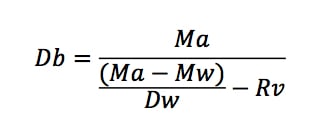
- Db = your body’s density.
- Ma = your dry weight.
- Mw = your weight when submerged.
- Dw = the density of the water.
- Rv = Residual volume (the volume of air in your lungs after a maximum exhalation).
4
Skinfold Measurements
With the right tools, you can also perform this at home, though it will require some practice and getting used to. This method is typically used by personal trainers, or in weight loss programs.
You’ll need calipers, used to measure your skin folds and estimate your body fat percentage. This method is favored by many because if you have the right tools and do it correctly, you can accurately keep track of your body fat.
2 Steps to Track Your Body Composition
If you have a solid understanding of body composition, you can track changes in it at home. Note that these methods are for estimating your overall body composition, but it’s unlikely that it will give you an exact, accurate number.
Still, it’s worth a try if you’d like to see your progress, but don’t have the means or money to go for scans or testing every so often. The premise of these home tests is to gauge your body composition by focusing on your weight and proportions.
Especially as a muscle builder, your workout will change your body, and even if you gain muscle, you will probably still lose weight (or fat, at the very least). So long as you pay attention to what you’re doing and make sure that you do it properly, you will get an idea of how much of your mass is fat.
1
Weigh Yourself Daily
One of the simplest weighs you can get an estimate of your body fat (or muscle mass), is to weigh yourself every day, and then determine an average at the end of every week.
This accounts for daily fluctuations that can otherwise meddle with weight readings, or cause them to be inaccurate. If your average is steadily rising (or decreasing), you’ll know that you are gaining mass.
The best way to go about this is to weigh yourself every morning (without clothes on, and after you’ve gone to the bathroom). Record each reading and at the end of the week, add them together, then divide by seven. This number will be your average.
2
Measure Yourself Weekly
This is a means to gauge what parts of you are changing. If you take your measurements (weekly is enough), you’ll be able to tell if you’re gaining muscle, or fat, or losing mass.
Often, bodybuilders (especially new bodybuilders) gain muscle as they lose weight, so their weigh-ins won’t change much.
Measuring yourself will add an extra level of accuracy to the averages you can calculate. You can use calipers if you have access to them, otherwise measuring tape will suffice.
The 4 Factors Affects Your Body Composition
Your lifestyle plays a significant role with your body fat, but there are other factors that you can’t do much about. Though the phrase “big-boned” holds little weight in science and health, some people are biologically bigger than others, and this could impact your body composition.
There are other contributing factors that you have little to no control over:
- Genetics: Your DNA determines whether or not you are predisposed to fat. A family history of obesity or overweight tendencies shouldn’t be overlooked. Your genetics also determine where you’re likely to store excess fat.
- Age: As people grow older, their muscle mass will deteriorate. In women, osteoporosis could also set in, decreasing their bone density. As you age your metabolism will also slow down, meaning you’ll be more likely to retain fat.
- Gender: As mentioned earlier, females have a higher threshold of body fat.
- Hormones: Your chemical makeup can influence your body composition too. Changes in your hormones (or problems with them) could cause you to hold more water. As with the above, it could also influence your bones or muscle mass as well.
Can You Change Your Body Composition?
Of course you can. You may not be able to change your height or genes, but through fitness, you can lose fat and gain muscle, which will change your fat percentage. A better question is, should you change your body composition?
You have to understand that your body still requires essential fats to be healthy and that zero percent fat shouldn’t be a goal (and isn’t healthy). That said, an excess of body fat is not a good thing and could put you at risk of dangerous, even life-threatening, illnesses.
If you are far outside of the suggested safe ranges, you should consider taking action to change your fat percentage. If you’re in good shape, but want to further increase your muscle or decrease fat, you’re at liberty to do so. Just be smart, and stay safe.
How to Do it
You don’t have to go out of your way to make changes to your body fat. In fact, if you’re a muscle builder, you’re already on the right track. The best way to decrease your body fat percentage is to go back to basics and use the three methods we already know the efficiency of.
1. Cardio
Cardio burns fat and strengthens your muscles, meaning that your bad fat will be replaced with lean mass over time. Aerobic exercise at a moderate intensity is one of the most effective ways to combat fat.
If your body needs more of a challenge, high-intensity workouts will be effective too. Just take care not to over-do it. Try to combine high and moderate intensities to get the full benefits of cardio, and to burn the most fat.
2. Resistance Training
Resistance training not only builds muscle, but it also sculpts and strengthens muscle too. You will not gain unnecessary weight in resistance training but will build lean mass while burning fat.
Resistance training is also excellent because the after-burn effect is greater. This means that you’re still burning fat, even after your workout.
3. Bodybuilding
Bodybuilding is perhaps the most obvious way to change your muscle composition because unlike cardio and resistance training, the goal is to grow your muscles. In bodybuilding you shouldn’t overlook cardio and resistance though, they’re still beneficial and will keep you strong and in shape.
4. Don’t Forget Your Diet
What you eat matters and is perhaps the biggest factor in body composition (outside of bodybuilding, of course). If you cut down on bad fats, your body will follow. The same applies to focusing on muscle-building foods (like protein), or supplements.
Summary
Body composition is one of the most important numbers you should focus on if you’re bodybuilding or trying to lose weight. It’s more accurate than measuring your BMI because it’s tailored to your body and specificities which proportion of you is fat.
You can alter your body composition through healthy lifestyle changes. Muscle building is one of the most effective ways to do so.






